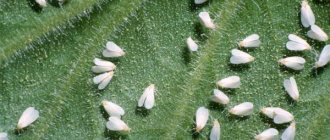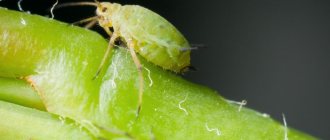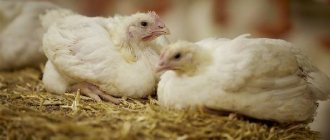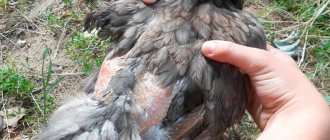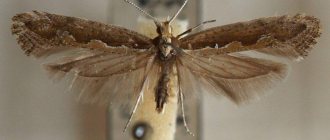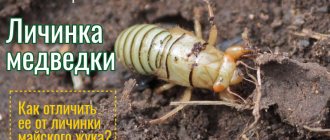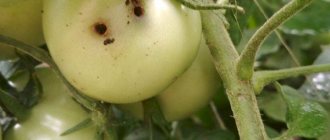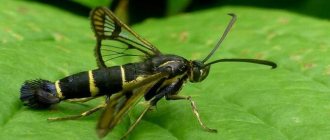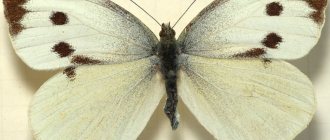Thrips on indoor plants are quite a common occurrence, further complicated by the fact that this insect is indiscriminate in terms of food. It successfully sucks juices from any species, without exception. This not only negatively affects the development of the flower, but can also lead to its death.
In addition, the pest multiplies quite quickly, which complicates its removal. It is important to know about measures to combat existing pests and how to protect indoor flowers from thrips invasion.
Biological description of the pest
The Thrips or Bladderfoot family, lat. Tripidae (Physapoda), belongs to the order Thrips or Fringed-winged, lat. Thysanoptera, from the class Insects, lat. Insecta. Distributed throughout the globe where plants exist. More than 200 species are found in Eurasia. Many of them are pests of plants grown by humans:
- Bulbous thrips, lat. Liothrips vaneeckei;
- Tobacco thrips, lat. Trips tabaci;
- Thrips barrens, lat. Haplothrips aculeatus$
- Bread thrips, lat. Limothrips cerealium;
- Thrips heterovorous, lat. Frankliniella intosa.
Most species are very small in size and have a similar body structure. It can be considered using the example of tobacco thrips, which is a pest of more than 100 species of plants cultivated by people.
Structure
The insect's body is small. Its length is from 0.8 to 1.5 mm, it is narrow and slender. Body color ranges from light yellow to brown. Due to the sloping forehead and lower lip, the triangular shape of the head resembles a cone, with its apex facing downwards.
The mouthparts are located on the head and are of the piercing-sucking type. There is a groove on the inside of the lower lip. Three bristles move along it. At their core, they are modified lower jaws. One, unpaired seta, pierces the tissues of the host plant. Two paired bristles widen the puncture and serve as a kind of tube for sucking out plant juices. There is also a pair of antennae on the head. Each of them consists of seven segments.
The prothorax is free. The mesothorax is fused with the metathorax. The pest's abdomen has 11 segments.
The tobacco thrips has three pairs of two-segmented limbs. They got their name bladderlegs because at the base of each limb there is a small, bubble-like swelling. The front pair of legs are yellowish in color.
The insect has four narrow wings. They are transparent, slightly yellowish. Their edges are decorated with fringe. Another name for the pest is associated with it - fringed winged. The veins on the wings are few in number.
Sexual dimorphism
Female tobacco thrips are larger than males. Their color is usually darker. This is especially true for spring females. Females have a saw-toothed ovipositor. They live longer than males. Only males are born from unfertilized females. During sexual reproduction, the number of females begins to predominate.
There are cases where males have reduced wings. Although individuals of both sexes can appear without wings.
The most common types
It is very difficult to distinguish between representatives of different species; most often only specialists can do this. All insects have a long slender body ending in a sharp tip. Its length does not exceed 1.5 cm , and for most it is only a couple of millimeters. The legs are adapted only for running, the mouthparts are of the sucking type. The wings are not wide, transparent.
The typical color of the body is black or dark brown ; it is observed in the vast majority of adult individuals.
The larvae molt several times, constantly changing color from the original pale yellow to dark red . The nymph (last stage) is practically indistinguishable from the imago, only the wings are missing.
Life cycle and offspring
Adult thrips overwinter in plant debris. The larvae can overwinter in the soil. The development cycle of tobacco thrips is typical for most species of these insects. It has six stages:
- Egg. In spring, the female lays white eggs in the plant tissue. Usually the eggs fall one at a time into the leaves, into the petals of a flower, into the bud. The egg stage lasts from 3 to 7 days.
- Larva of the first instar. It is white in color, no larger than an egg, mobile, wingless, and begins to feed immediately after emerging from the egg. The stage lasts up to 3 – 4 days.
- Second instar larva. Larger than the previous stage, longer limbs, also has no wings, actively feeds for 6 - 8 days. Leads a hidden lifestyle.
- Prepupa or pronymph. Falls from a plant to the ground. Although it may remain on it. Doesn't eat. It can go into the soil to a depth of 15 cm. The rudiments of wings are there, but they are almost invisible.
- Pupa or nymph. Longer than prepupa. The transformation takes place in the ground. The stage lasts for 4 – 5 days. Doesn't eat. The pupa has clearly visible wings and antennae that are bent back.
- Imago. Emerges from the pupa. With a humidity of 70% and a temperature of + 23 + 27 degrees, the full development cycle takes from 14 to 20 days. At lower temperatures, the cycle extends to 30 days.
Number of offspring. One female, under favorable conditions, lives on average 18–25 days. During this time, she can lay from 50 to 80 eggs. In favorable seasons, the number of eggs from one female individual increases to 100 - 150 pieces.
After the emergence of adult adults from the first clutch, the number of pests quickly increases several times. During the warm season there can be from one to three to five generations.
Causes of thrips
As a matter of fact, the main reason for the appearance of thrips is their hunger. Parasites also want to eat. The main thing is that you must understand that thrips do not start on their own. You can only bring them into the house in different ways.
Most often, thrips enter homes and areas in the following way:
- They fly through windows when you ventilate the room. They can also simply be blown towards you by the wind. Thrips are capable of migration, however, they are still not storks that can fly 1000 km.
- Thrips can move to you from neighbors in your garden or apartment.
- Be careful when purchasing a new plant. Examine it carefully, because... thrips are very difficult to detect, otherwise you will spread them throughout the house.
- In the same way, carefully examine the plant that you picked somewhere in the garden or in the field.
Be most wary of thrips in hot, dry regions, as this is where these pests are most common. Heat, dryness and summer wind are ideal conditions for thrips to appear.
Harm from thrips to plants
Tobacco thrips and other related species pose a threat to many outdoor and indoor plants. Almost all of them are polyphagous and damage plantings of tomatoes, peppers, eggplants, cucumbers, berries, fruits, grains and ornamental crops. They are dangerous for onions and bulbous plants. They can parasitize many indoor flowers.
What are the dangers for plants and crop loss?
The pest is dangerous because it is very difficult to detect it at the very beginning. The first spring generation develops not on cultivated plants, but on weeds. Thanks to their wings, adult insects very quickly fly to vegetable, fruit, grain, decorative, and technical plantings.
Despite the fact that only three of the six stages of development feed on plants, they cause significant yield loss. If there are no more than 5 larvae on one plant, then the losses range from 10% to 20%. If 12 larvae feed on one vegetable, berry, or grain bush, then crop losses will exceed 50%. During storage, the harvest of bulbous crops can be seriously damaged.
Very often thrips damage the buds. This reduces the yield of marketable products. Sometimes it completely destroys plantings of flowers suitable for cutting.
By sucking plant juice from leaves, flowers, and ovaries, thrips disrupt nutritional processes and cause wilting of the vegetative and generative parts. They also carry pathogens of viral diseases.
Symptoms of plant damage
As soon as the first instar larva begins to feed, discolored gray-silver spots appear on the leaf blades and other organs of the plant. As the parasite feeds, the spots grow in size, merge, and cause them to die.
If the larva feeds in the buds, they look sticky and do not open. The ovary and fruits damaged by thrips have a twisted and asymmetrical shape.
Conclusions about the damage of plants by thrips can be made if you see black or green dots on them. These are traces of pest excrement.
How to spot thrips
Most thrips species lead a hidden lifestyle, making them almost impossible to detect. Even gardeners with many years of experience do not always manage to notice the parasite in time. And how can you spot it when it’s hidden, for example, between the scales of an onion? However, there are ways that will allow you to identify the problem:
- Daily inspection.
- Pay special attention to inspecting the leaves from the reverse side. Thrips suck the juices out of the plant, so it is on the back of the leaves that the first spots will appear. Small holes in the leaves are a sign of the pest.
- The leaves will begin to fade, but this is already a more advanced stage of the parasite’s “work.”
- There may be mucus on the leaves and stem that sticks to your hands. This is a clear sign of a pest.
- Presence of silvery spots and stripes.
- Withering of buds.
- Deformation of the stem, flowers and leaves.
- The plant begins to bloom later than usual, and goes into “hibernation” earlier.
Means for fighting
There are several methods to combat thrips on cultivated plants.
Chemicals
The following can be considered the most effective chemical control agents:
- Alatar. The drug contains two active ingredients. The first is malathion, its content is 22.5%, the second is cypermethrin, its amount is 5%. Chemical class: pyrethroids + organophosphorus compounds (OPS). The presence of adhesive substances in the preparation increases its effectiveness. The active compounds belong to different chemical classes; the drug deals a double blow to the pest and leaves it almost no chance. On plants, the activity of “Alatar” lasts up to 20–30 days. Sold in containers convenient for personal households - in ampoules of 5 ml and in bottles of 25 ml and 50 ml. To treat vegetable, berry, and fruit crops, it is enough to dissolve 10 ml in 10 liters of water. Hazard class for people 3, for bees 1. In addition to thrips, it is used against a wide range of pests such as: Colorado potato beetle, cabbage moth, whiteweed, cabbage cutworm, aphids, scale insects, leaf rollers, onion fly and others.
- Movento Energy. An effective two-component drug. Contains the active substances imidacloprid and spirotetramat. Chemical class: neonicotinoids. It has a systemic effect on the pest, works as an intestinal and contact insecticide. It disrupts the transmission of nerve impulses and deprives adult insects of the ability to reproduce. The death of thrips occurs in the first hours after treatment. Remains effective for up to 2 – 3 weeks. Available in the form of a concentrated suspension. Hazard class for humans 3, for bees 1. The drug is approved for use in private household plots (Personal subsidiary plots). In addition to thrips, it is used against a large number of harmful insects such as: Colorado potato beetle, aphids, leafhoppers, leaf rollers, leaf phylloxera, Colorado potato beetle, greenhouse whitefly and others.
- Confidor Extra , VDG (Water-dispersible granules). The drug has the active substance imidacloprid 700 g/kg. Chemical class: neonicotinoids. According to the method of penetration, Confidor Extra belongs to: intestinal, contact and systemic pesticides. Hazard class for humans: 3 (moderately hazardous compound), for bees: hazard class 1. The drug is used against a wide range of pests of open and closed ground.
- Aktara , VDG (Water-dispersible granules). Chemical class of the drug: neonicotinoids. Method of penetration: Intestinal, contact and pesticide. Hazard classes for humans/bees: 3/1. The manufacturer of Aktara is Syngenta. The drug is approved for use on private farms and is used against many pests, including thrips, on various agricultural, fruit and flower crops.
- Dicarzol (Dicarzol). Made in Italy. Non-systemic insecticide, acaricide with contact and stomach action for the control of thrips, red mite and whitefly. It acts on the nervous system of insects as an inhibitor of acetylcholinesterase. Consumption rate: 100 g of the drug per 100 liters of water (10 g per 10 l).
- Nocturne, Nocturn. Nocturne pyridalil 100 g/l 5l. Nufarm GmbH & Co. KG Insecticide against thrips. It is used on such crops as: tomatoes, cucumbers, eggplant, peppers, roses (open and closed ground). Consumption of the drug: 0.1% 100 ml / 100 l of water (10 ml per 10 liters of water).
Table: the most effective drugs against thrips
| Drug, hazard class for humans/bees | Norm | Culture | Harmful object | Method, processing time and features | Waiting period (number of treatments) | Output deadlines for manual (mechanized ) work |
| Vantex, ISS 3/1 | 0,06-0,07 | Wheat, barley | Bread beetles, thrips, grain flies | Spraying during the growing season. Working fluid consumption - 200-400 l/ha | 36(2) | -(3) |
| 0,08-0,1 | Onion | Tobacco thrips | Spraying during the growing season. Working fluid consumption - 200-300 l/ha | 14(2 | -(3) | |
| 0,04-0,06 | Oil flax | Flax thrips, flax moth, cotton bollworm | Spraying during the growing season. Working fluid consumption - 200-400 l/ha | 51(1) | -(3) | |
| 0,04-0,06 | Fiber flax | Flax thrips, flax moth, cotton bollworm | Spraying during the growing season. Working fluid consumption - 200-400 l/ha | -(1) | -(3) | |
| Confidor Extra, VDG 3/1 | 0,03 | Wheat | Thrips | Spraying during the growing season. Working fluid consumption -200-400 l/ha | 20(1) | 7(3) |
| 0,4 | Protected soil cucumber | Aphids, tobacco thrips | Application under the root with drip irrigation or dosed root application. Plant height more than 1 m | 3(1) | 1(-) | |
| 0,35 | Protected soil cucumber | Aphids, tobacco thrips | Application under the root with drip irrigation or dosed root application. Plant height less than 1 m | 3(1) | 1(-) | |
| Tanrek, VRK 3/1 | 0,3 | Open ground flower crops | Aphids, leafhoppers, thrips | Spraying during the growing season. Working fluid consumption - 500-1000 l/ha | -(1) | 3(3) |
| 1 | Flower crops in protected soil | Greenhouse whitefly, aphids, thrips, western flower thrips | Spraying during the growing season. Working fluid consumption - 1000-2000 l/ha | -(1) | 1(-) | |
| Spintor 240, SK 3/1 | 0,3-1,2 | Protected ground cucumber and pepper | Western flower thrips | Spraying during the growing season with 0.03-0.04% working solution at intervals of 7-10 days. Working fluid consumption – 1000-3000 l/ha | 5(2) | 2(2) |
| 0,2-0,75 | Flower crops in protected soil | Western flower thrips | Spraying during the growing season with 0.04-0.05% working solution at intervals of 7-10 days. Repeat the treatment cycle, if necessary, after 28-35 days. Working fluid consumption – 500-1500 l/ha | -(2) | 2(2) | |
| Aktara, VDG 3/1 | 0,8 | Protected soil cucumber | Aphids, tobacco thrips, whitefly | Application under the root during drip irrigation. Plant height is more than 1 m. Working fluid consumption - 2500-5000 l/ha | 3(1) | 7(3) |
| 0,4 | Protected soil cucumber | Aphids, tobacco thrips, whitefly | Application under the root during drip irrigation. Plant height is less than 1 m. Working fluid consumption – 2500-5000 l/ha | 3(1) | 7(3) | |
| 0,8 | Protected soil eggplant | Aphids, tobacco thrips, rose thrips | Application under the root during drip irrigation. Plant height is more than 1 m. . Working fluid consumption – 2500-5000 l/ha | 3(1) | 7(3) | |
| 0,4 | Protected soil eggplant | Aphids, tobacco thrips, rose thrips | Application under the root during drip irrigation. Plant height is less than 1 m. . Working fluid consumption – 2500-5000 l/ha | 3(1) | 7(3) | |
| 0,8 | Protected ground pepper | Aphids, tobacco thrips | Application under the root during drip irrigation. Plant height is more than 1 m. Working fluid consumption is 2500-5000 l/ha. | 3(1) | 7(3) | |
| 0,4 | Protected ground pepper | Aphids, tobacco thrips | Application under the root during drip irrigation. Plant height is less than 1 m. Working fluid consumption is 2500-5000 l/ha. | 3(1) | 7(3) | |
| 0,2-0,4 | Onion | Tobacco thrips | Spraying during the growing season. Working fluid consumption - 200-400 l/ha | 7(2) | 7(3) | |
| 1,6 | Open ground rose | Thrips | Spraying during the growing season. Working fluid consumption – 500-2000 l/ha (concentration – 0.08%) | -(1) | 7(3) | |
| 1,6 | Protected soil rose | Thrips | Spraying during the growing season. Working fluid consumption – 500-2000 l/ha (concentration – 0.08%) | -(3) | 7(3) | |
| Bi-58 Novy, KE 3/1 | 1-1,2 | Wheat | Bug bug, beech bug, grain flies, aphids, thrips | Spraying during the growing season. Working fluid consumption - 200-400 l/ha | 30(2) | 10(4) |
| 1 | Rye, barley | Pyavitsa, grain flies, aphids, thrips | Spraying during the growing season. Working fluid consumption - 200-400 l/ha | 30(2) | 10(4) | |
| 0,5-0,9 | Vegetable crops (seed crops) | Mites, aphids, thrips, bedbugs | Spraying during the growing season. Working fluid consumption - 200-400 l/ha | -(2) | 10(4) | |
| 0,5-0,9 | Fiber flax | Codling moths, thrips, gamma armyworm | Spraying during the growing season. Working fluid consumption - 200-400 l/ha | -(2) | 10(4) | |
| Voliam Flexi, SK 3/1 | 0,4-0,5 | Grape | Bunch leaf roller, thrips, leafhoppers | Spraying during the growing season. Working fluid consumption – 600-1000 l/ha | 14(3) | 7(3) |
| Iskra Zolotaya, VRK 3/1 | 0,5-1,5 | Protected soil cucumber | Greenhouse whitefly, aphids, thrips | Spraying during the growing season at a concentration of 0.05%. Working fluid consumption - 1000-3000 l/ha | 3(1) | 3(3) |
| 0,5-1,5 | Protected soil tomato | Greenhouse whitefly, aphids, thrips | Spraying during the growing season at a concentration of 0.05%. Working fluid consumption - 1000-3000 l/ha | 5(1) | 3(3) | |
| Karate Zeon, ISS 3/1 | 0,2 | Wheat | Bread beetles, thrips, flea beetles, leafhoppers | Spraying during the growing season. Working fluid consumption: for ground spraying - 200-400 l/ha, for aviation - 25-50 l/ha | 40(1) | 10(4) |
| 0,15-0,2 | Barley | Flies, leechweed, leafhoppers, thrips, stem sawflies, aphids | Spraying during the growing season. Working fluid consumption: for ground spraying - 200-400 l/ha, for aviation - 25-50 l/ha | 40(2) | 10(4) | |
| 0,1-0,125 | Peas | Pea gnat, aphids, thrips, nodule weevils | Spraying during the growing season. Working fluid consumption - 200-400 l/ha | 30(1) | 10(4) | |
| 0,15-0,2 | Onion | Tobacco thrips | Spraying during the growing season. Working fluid consumption - 200-300 l/ha | 25(2) | 10(4) | |
| Fitoverm, KE 3/3 | 0,4-0,12 | Cucumber, tomato, pepper, eggplant, protected soil | Spider mites, tobacco mites, western flower thrips | Spraying during the growing season with an interval of 20 days. Working fluid consumption – 1000 – 3000 l/ha | 3(3) | 1(1) |
| 0,6-1,2 | Protected soil rose | Western flower thrips | Spraying during the flowering period with an interval of 7 days. Working fluid consumption – 1000 – 1500 l/ha | 1(3) | 1(1) | |
| Fufanon Expert, VE 3/1 | 0,7-1,6 | Wheat, barley | Aphids, wheat thrips | Spraying during the growing season. Working fluid consumption – 200-400 l/ha | 30(1) | 10(3) |
| 0,8-1,6 | Cabbage | Whiteflies, cabbage cutworms, moths, aphids, thrips, whitefly | Spraying during the growing season. Working fluid consumption - 200-400 l/ha | 20(2) | 10(3) | |
| 0,8-1,6 | Open ground cucumber | Mites, sprout fly, aphids, thrips, whitefly | Spraying during the growing season. Working fluid consumption - 200-400 l/ha | 20(2) | 10(3) | |
| 1,5-4,5 | Protected soil cucumber | Mites, thrips, greenhouse whitefly | Spraying during the growing season. Working fluid consumption - 1000-3000 l/ha | 1(1) | 3(-) | |
| 1,5-4,5 | Protected soil tomato | Mites, thrips, greenhouse whitefly, nightshade leaf miner | Spraying during the growing season. Working fluid consumption - 1000-3000 l/ha | 1(1) | 3(-) |
Entomophages
The action of biological agents to combat thrips is based on the existence of natural enemies of these insects. Today, the most effective are preparations containing the predatory bugs orius levigatus, lat. orius laevigatus. These insects are universal entomophages.
Thripol-L. Available in tubes containing 500 adult bedbugs and their nymphs or 2000 bedbugs and nymphs. In addition, there is a natural filler - buckwheat husk mixed with vermiculite. After settling on plants affected by the pest, adult individuals begin to actively feed on all mobile stages of thrips development, damaging its integument with piercing-sucking mouthparts and sucking out vital juices. Nymphs feed on older larvae. The drug has proven itself in the fight against thrips on strawberries, melons, beans, and sweet peppers. It is used on both indoor and open ground crops. Orius bugs have wings and move quite quickly in search of the pest.
Amblyseius is a predatory polyphagous mite belonging to the Phytoseiidae family. The insect feeds on thrips (first instar larvae), spider mites and some other plant pests.
Macrolophus is a predatory polyphagous bug of the horsefly family (Miridae). The entomophage prefers to feed on whiteflies, aphids, thrips, spider mites and other pests.
Biological agents
Biostop – belongs to the chemical class bacterial insecticides + biological pesticides. The drug acts on pest organisms as an acaricide, insecticide and pesticide. Biostop is used on vegetables, fruits and berries, grains and other crops. Protects them from pests such as thrips, meadow moth, bollworm (caterpillars of 1-3 instars), aphids, leaf rollers and others.
Fitoverm (emulsion concentrate) belongs to the chemical class avermectins + biological pesticides. Active ingredient aversectin C 50 g/l. Method of penetration of the drug: intestinal and contact pesticide. Acts on pest organisms as an acaricide, insecticide and pesticide. Hazard class for humans and bees: 3. Used against tobacco, western, flower thrips on cucumbers, tomatoes, peppers and eggplants in protected ground in an amount of 4 ml per 10 liters of water. Against thrips on flower crops in greenhouses in the amount of 3.2 ml per 10 liters of water. From thrips on indoor plants in the amount of 0.4 ml per 1 liter of water. Against thrips on open ground flower crops in the amount of 4 ml per 10 liters of water.
Spintor 240 belongs to the chemical class - biological pesticides. The active ingredient is spinosad. It is produced from the bacteria Saccharopolyspora spinosa. The drug has a contact-intestinal action. Release form: suspension. Affects the nervous system of the pest. The death of the parasite begins within a few minutes after spraying the plants. Hazard class for humans is 3, for bees – 1. To increase efficiency, plants are treated three times with an interval of 7 days.
Antonem-F (aqueous suspension). Belongs to the chemical class biological pesticides + entomopathogenic nematodes. Active ingredient of the drug: Steinernema feltiae (Filipjev). Anthonem-F belongs to the 4th class of danger to humans. Used against Western flower thrips on roses. Also against a number of other pests on potatoes, cabbage, currants and other plants.
Traditional methods
Folk remedies in the fight against thrips are not as effective as chemicals, but they are less toxic.
Infusion of tobacco. To combat thrips, you need to take a tablespoon of crushed dry tobacco leaves or tobacco crumbs. Fill it with 1 liter of hot water. Close the container with a lid and keep the contents for 1 day. Combine the resulting infusion with another liter of water. Spray the plants. Repeat the treatment after 7 days.
Garlic infusion. Pour 600 ml of water into the pan. Heat it to a boil. Chop 5 – 6 cloves of garlic and add them to boiling water. Leave for 5 – 6 hours. Strain through cheesecloth. Using a brush, apply to plant leaves on both sides. The method is good with a minimum number of infected plants.
Prevention during the growing season
Even if you have prepared responsibly and carried out full preventive measures in the fall, you may have lazy neighbors who have forgotten about the existence of this superweapon among pests. We are preparing to repel an attack, and they will help us with this:
- Regular watering of plants. It must be remembered that in dry air thrips reproduce especially intensively, so we deprive them of this favorable condition.
- Mulching. It will help us retain moisture.
- Constant removal of old and fallen flowers and leaves;
- Permanent destruction of all weeds.
Treatment methods if tobacco thrips appears on your site
The difficulty of controlling this pest with insecticides is due to the characteristics of development at various stages. Let's consider methods of struggle.
1. Agrotechnical.
- Planting onions, as the most possible carrier of thrips, at the maximum possible distance from other crops and plants;
- Constantly rinse the affected areas with water from a hose.
2. Chemical control methods.
- Actellik. Dilute 2 ml of the drug (ampoule) in two liters of water. In case of severe damage, dilute Actellik in one liter. Do not forget that spraying is carried out in calm weather. The treated plant must be covered with a plastic cap, which is removed after a day.
- Vertimek. Consumption - 2.5 ml per 10 liters. We also take precautions and wear a cap.
- Agravertine. When using it, read the instructions carefully, because... The ratio of drugs and water varies depending on the type of plant.
- Karate. The amount of the drug used also depends on the type of plant.
- Confidor Extra. Resistant to precipitation. Consumption - 2 grams of the drug per ten liters of water. We pour Confidor between the rows. It can also be applied along with fertilizers.
- Sulfur smoke bomb "Climate". Processing of an empty room for storing crops is carried out no later than a week before laying the fruit. Application - 300 grams per 10 cubic meters. After using the drug, keep the storage area closed for 30 hours. After this, we ventilate for two days.
It is better to alternate preparations for treating damaged plants to avoid thrips adapting to them. Treatment is carried out at least twice with a break of 5 - 6 days, so that it is possible to hit the pest at different stages of development. But processing should not last more than ten days. Be sure to carefully study all instructions for using insecticidal preparations! There are also paraprofessional remedies that provide a prolonged effect. But in order to use them on your site, you need to have knowledge in this area. It is better to contact specialized companies. Our specialists carry out the entire complex of pest protection - from diagnostics to treatments and monitoring the results.
3. Biological method.
A good effect is achieved by releasing the Phytoseilus mite, which is a predator, onto the affected plants. Purchase ticks in specialized stores. Biological methods are difficult to use independently.
Thrips are also destroyed by Orius and Antokorisa bugs. The effectiveness of these bugs depends on the correct use of the method, for example, bedbugs need to have flower pollen for nutrition.
4. Folk remedies.
- Onion peels - 1 kg of onion peels are brewed with water (2 l). After settling for two days, add 6 liters of water and add soap to effectively adhere the infusion to the plants.
- A decoction or infusion of tobacco dust - in the ratio of one part by weight of dust per ten liters of water;
- Decoctions and infusions of yarrow, celandine, capsicum.
It is important to remember that their use is effective only when the thrips infestation is low. Don't miss the moment of uncontrolled reproduction of the pest. It is also necessary to remember such an important event as a thorough inspection and drying of the fruits before storing them in storage.
Tobacco thrips is a serious and insidious enemy. But, as they say, the stronger the enemy, the tighter your fist. We hope the information above will help you grow a decent harvest. If you want to relieve yourself of the worries of regular garden treatments, then we are always happy to help with pest control, please contact us!
Pest on indoor plants
Fans of indoor floriculture should be prepared that their plants may suffer from various genera of thrips. As a rule, these are the following types of pests:
- bulbous;
- tobacco;
- floral;
- decorative;
- heterovorous.
If the plants show signs of infection, it is advisable to wash them in the shower. After this, move all pots with suspicious flowers to a separate room. If possible, you need to transplant the plants into new soil or replace its top layer. If the damage is minor, all parts of indoor flowers can be treated with any folk remedy, for example, garlic infusion. If buds or flowers appear on diseased indoor plants, they need to be removed, as thrips love to feed on them.
Preventive measures
Compliance with preventive measures will prevent the pest from appearing on flowers, and in case of infection, it will allow the fight to begin as quickly as possible.
- Increased air humidity. Bugs prefer dry, warm air; in such conditions they reproduce most quickly;
- Regular inspection of home flowers will make it possible to recognize the disease in the early stages;
- A “bath day” once a month will have a beneficial effect on green pets - dust will be washed away, as well as random parasites;
- A 30-day quarantine is required for new plants;
- It is advisable to place bouquets with greenhouse and wildflowers away from indoor plants - they can become a source of pests.
Paying close attention to your green pets will help prevent damage from dangerous pests.
On cucumbers
You can detect the first signs of thrips damage to cucumbers using a magnifying glass. On the upper side of the leaf blades you can see small silvery dots, and on the lower side you can see larvae or adults. They are easily distinguished from other pests by their two pairs of fringed wings. If they are disturbed, they begin to make sharp jumps, pushing off the surface with their abdomen.
When using folk remedies such as infusion of tobacco or garlic, you will have to carry out treatments every 7 days. Better results can be achieved by treating cucumber plantings with chemicals, for example, “Alatar”. To do this, dilute 5 ml of the drug in 1 liter of water, stir, bring the volume to 5 liters and spray the cucumber bed. This working solution is enough to treat plantings on an area of 1 sq.m.
Wheat
It can feed on many plants, but its favorites are cereals, both cultivated and wild. In addition to wheat, they eat rye , buckwheat , barley , corn , oats , tobacco , and cotton .
If there is no favorite food nearby, wheat thrips may attack weeds.
The color is always dark - black or brown, the legs and antennae are yellow. The length of the female is up to 2.5 mm , the male is half as long.
The life cycle is longer than other thrips species and the fertility is less. Standard clutch - up to 25 light red eggs .
IMPORTANT! Mass emergence of adults occurs when cereals begin to ear.
On tomatoes
If small light spots appear on the leaves of tomato bushes, which gradually grow and merge, and black dots of pest excrement can be seen on different parts of the bush, then pest control measures must be immediately applied. In case of minor damage, the leaves are washed with garlic infusion or biological preparations.
To combat pupae, the soil around the plants can be spilled with mustard solution. To do this, dilute 1 tablespoon of mustard powder with a liter of water. If there are a lot of diseased plants, then they will have to be treated with available chemicals recommended for killing thrips. After spraying tomatoes with insecticides, it is advisable to cover them with a transparent film for several hours.
Thrips in indoor floriculture
Houseplants can suffer greatly from a thrips infestation. They stop developing and stop blooming. The leaves become covered with necrotic areas, dry out and fall off. The most delicious for many species are orchids , ficus and violets .
The pubescent leaves of Saintpaulia are attacked by decorative and onion species. They can easily be confused with sciarid flies. The main distinguishing feature of an attack by thrips is the petals of the inflorescences, stained with pollen . It spills out from the stamens where pests live.
Thrips are frequent visitors to orchids, as this is one of the pest’s favorite treats . They are attacked by ornamental , tobacco , rose , and dracaena thrips . Multiple silvery spots appear on the leaves - bites and necrosis, which gradually turn black.
Ficus plants are attacked by dracaena , ornamental and Californian thrips . Not only do they suck out the juices, necrotizing the foliage, but they also spread viruses. Ficuses affected by viral diseases can no longer be cured.
Thrips on ficus and violets, photo:
In the greenhouse
You can fight thrips in greenhouses with the help of biological preparations, for example, Thripol-L. To increase its effectiveness, it will be necessary to increase daylight hours to 14 hours. If this is not possible, then introducing a predatory bug (or other entomophages) into greenhouse structures is more effective only from April to September.
Using glue or pheromone traps will help reduce the number of adults. It is important to know that the latter option is effective in catching males. Their use must be combined with the simultaneous placement of glue traps.
Tobacco or onion
Almost omnivorous insects, happily eating even tobacco , garlic and any type of onion . The favorites of the diet are all nightshade and umbelliferous crops , and many flowers .
Onion thrips likes to settle in greenhouses , greenhouses and hotbeds , where it is almost impossible to remove it completely.
Unlike other varieties, adult tobacco thrips are colored in light shades - beige , yellow , light brown .
They develop much faster than wheat and other thrips; as many as 7 generations are born per season. Does not tolerate heat, dying at 38-42°.
Prevention
Preventive measures will help protect plants from various types of thrips:
- systematic inspection of plants;
- compliance with quarantine measures when purchasing seedlings, seedlings, and adult specimens;
- regular removal of weeds, including near greenhouses;
- installation of small protective nets in greenhouse structures;
- compliance with crop rotation;
- thorough cleaning of tops and plant debris;
- Digging the soil before the onset of winter.
Divorceous
As the name suggests, it is a very omnivorous insect. It parasitizes vegetables , berries , fruit trees and shrubs , and indoor flowers .
The body color is predominantly brown; there are dark spots on the wings, diluted by a cream stripe at the base.
The female hides the eggs inside the stems of food plants, sometimes in the sepals, where they are difficult to detect. Although this species is not a quarantine pest, it can cause serious damage in greenhouses and conservatories.
IMPORTANT! This insidious pest often causes damage to the developing ovary and inflorescences! It is recommended to get rid of these as soon as possible!
Morphology and biology of the pest
Recognizing thrips is not that difficult. They look like small insects with an elongated body up to 2 mm long, light yellow, black or dark brown. Adults usually have two pairs of wings with long hairs.
The larvae of the pest have a light yellow body and do not exceed 1 mm in length. An additional clue about the presence of thrips can be the nature of their movement: adult individuals move very quickly, often making sharp jumps using their belly.
The difference between males and females is that the former have a slimmer, but not so long body. They are also painted in different colors.
Thrips can also be distinguished by their wings: in some species they can be quite short, in others they may not be at all. Thrips are one of many groups of pests that include more than 2,000 species. About 200 species live in our country.
Their main habitats are leaves, flowers and buds of indoor plants. They feed on nectar and sap from leaf tissue. Thrips are dangerous because they reproduce very quickly. Leaf tissue or flowers are used as a site for laying eggs.
After just 10 days, new offspring emerge from the eggs. However, it takes one month for the larvae to develop into adult insects.
At this moment, a great threat appears for plants, since as a result of the activity of pests they lose their attractiveness and begin to be affected by viral diseases. Over time, when insects drink all the juices from one plant, they move on to others located nearby.
So what are flower thrips? As we have already said, this is a small insect, usually one and a half millimeters long, but there are adults with a length of up to two and a half millimeters. Their wings are folded behind their backs; in a calm state, they form a light, narrow strip that is barely visible.
Adults are brownish, black or sandy in color, young ones are greenish, whitish, yellow. It is thanks to their camouflage coloring that these insects hide well and are difficult to detect.
The larvae do not have wings, they are small; quite a lot of effort must be made to detect and destroy them. Most insects hide among the stamens of the flower, in the axils of the leaves, so if you notice the first signs of damage, inspect your plant very carefully. The sooner you take action, the better for your pet.
When deciding how to deal with thrips on flowers, you must first become familiar with them and their biology in a little more detail. The biggest difficulty is their small size, several stages of development and virtually imperviousness to chemicals.
A single treatment of a plant can only slightly reduce the number of pests, but it will not be possible to completely remove them in one go.
Therefore, when fighting insects, it is recommended to divide the entire period into several parts, gradually destroying the pests. We also take into account that the eggs are not affected during processing, since they are located directly in the leaf tissue. Therefore, it is necessary to remove the affected leaves and carefully examine the remaining ones. Fighting thrips with pesticides may also not be successful, since they adapt well to any poisons.
At the larval stage, insects are generally inaccessible; they simply bury themselves in the ground near the root system, where there is no way to get them. Typically, two to three times the concentration of insecticides is required to cope with insects, which are incredibly resistant compared to other pests. The most stringent control measures are required here.
Common types of thrips
The first information about the existence of thrips was received back in 1744, when these pests were discovered by Karl de Geer. Today, people have become more aware of the species diversity of these pests, among which there are special species that infect ornamental plants more often than others:
The length of an adult insect is about 2 mm, the color can vary from light yellow to brown-yellow. California thrips prefer to live on buds and flowers, but the population can also reproduce on leaves.
California thrips are dangerous because they carry the tomato virus, which gives tomato leaves a bronze color. Western flower thrips is considered a very broadly polyphagous species.
It can feed on peppers, cucumbers, onions, tomatoes, grapes, peaches, strawberries and many other fruit and vegetable crops, as well as numerous ornamental and flower plants: gerberas, roses, daisies, chrysanthemums, Saintpaulias, cineraria, cyclamens.
Western flower thrips larvae and adults suck cell sap from plant tissue. This first causes the appearance of yellow spots on the buds, leaves or fruits, streaking; Gradually, plant tissues die in these affected areas.
Damage to flower buds in vegetable and fruit crops causes deformation of flowers and fruits.
For example, severe curling of flowers and curling of the fruits of a cucumber are a common sign that thrips has settled on the plant. When roses are infested with Western flower thrips, damaged buds do not open and dry out.
This pest lives in the middle zone and southern regions of our country. Here it is found on various ornamental plants grown in greenhouses and greenhouses. The insect itself is small, reaching a length of no more than 1 mm, and has a light yellow or brown color.
It is most widespread in the northern regions and central zone of our country. Poses a threat to many indoor plants.
Orchids, monstera, dieffenbachia and certain types of palm trees suffer the most from this pest. It can be identified by its dark brown color, as well as a small body that is 1.5-2 mm long.
Adult insects are about 1.3 mm long, females are yellow-brown in color, the male is slightly smaller and lighter. The larvae are white. This type of thrips is also a large polyphagous plant and is found on the leaves of a very large number of species of ornamental plants: orchids, monstera, aralia, tradescantia, anthurium, hibiscus, ficus, dracaena, palms and many others.
Under natural conditions, dracaena thrips is found in tropical and subtropical countries. In more northern latitudes it is widely distributed on plants in closed ground (in greenhouses, greenhouses).
In industrial greenhouse conditions, it is almost impossible to destroy thrips. At best, their numbers are kept to a level that would not affect the commercial quality of the products (flowers, fruits, vegetables).
This is due to the fact that thrips have a very high adaptation to pesticides. This is especially true for individuals that feed on flowers.
This species is represented in most of our country. The main food for it is flowers and buds of indoor plants. It looks like a dark brown insect, reaching a length of just over 1 mm.
Its favorite habitats are rosaceous plants. A characteristic feature is a brown body, reaching 1 mm in length.
This species is represented in most of our country. Most often it can be found among the scales of lily plants. It can be identified by its dark brown color and body up to 2 mm long.
The insect is dark brown or brown in color, from 1.3 mm (males) to 1.6 mm (females) in length. Echinothrips americana prefers to live mainly on leaves, in the tissue of which females lay their eggs. This type of thrips was discovered in the nineties of the last century in Holland at one of the popular flower auctions, to which plants are brought from all over the world.
Initially, thrips was discovered on orchids. Nowadays, American thrips are transported from country to country on cut flowers, seedlings, and ornamental potted plants.
American thrips activity is first visible by the appearance of yellow spots. The presence of ten thrips on one leaf is enough for it to begin to fade. 30-40 thrips individuals will lead to drying out and leaf fall, which begins from the lower tier. And although thrips do not directly lead to plant death, they significantly reduce the decorative value of flowers.
In search of food, thrips move to flowers and fruits or to neighboring plants and continue their life activities there. Due to the fact that the population of American thrips is spreading very quickly, there is a high probability of its spread not only on all floral and ornamental plants, but also on other vegetable crops grown in greenhouses.
Adult insects are about 1-1.5 mm long, dark brown or almost black in color with a brownish-brown abdomen and yellowish fore wings. The larvae are white or yellowish, differ from adults in being slightly smaller in size and lacking wings.
Adult insects and black thrips larvae usually live on the underside of leaves. The nature of plant damage is almost the same as that caused by tobacco thrips.
In closed ground (in greenhouses, greenhouses), black thrips is ubiquitous and reproduces all year round. Harm is caused by both adult insects and black thrips larvae, causing great damage to cucumbers, tomatoes, other vegetable and green crops, as well as potted and ornamental plants. Black thrips overwinters well in the top layer of soil under plant debris or in compost heaps.
What indoor plants do insects appear on?
These insects are omnivores and live on any plants. Their favorite indoor flowers are violets, ficus, lemons, begonias, roses, orchids and dracaenas. Thrips cause particular harm to violets, damaging the flowers.
The plant stops blooming and loses its decorative appearance.
The most favorable climate for insects is warm and dry air. They can appear in any home, but they actively reproduce most often in places where the plants are not sprayed or rarely watered.
How to detect and signs of flower infection
If, during the inspection of indoor plants, you find that some leaves have become discolored, and there are also many spots on them caused by punctures, then this is a clear sign that thrips have appeared in your apartment. If you pay attention to the lower part of the leaves, you can find brownish or brownish spots there.
Damaged areas often turn silvery, which can be explained by air entering the cells.
If prompt treatment measures are not taken at the first signs of thrips activity, the foliage will subsequently die and flowers and buds will become deformed. Insects cause additional harm by depositing sticky secretions, which provide a favorable environment for the development of sooty fungus.
Although thrips are not picky about their food, their most preferred indoor plants are violets, begonias, roses, citrus fruits, orchids and ficus. Violets suffer most from thrips larvae, as they destroy the anther of the flower.
At the first signs of their appearance, it is necessary to pick off all flowers and buds over the next 1.5 months, combining this with treatment with suitable preparations.
Unfortunately, the presence of insects is often discovered when the plant has already died. They hide in the axils of leaves and pistils of flowers. If you carefully examine the plant, you can find the following signs of thrips infestation:
- Small brown dots on the leaves are places from which insects drank juice;
- Many leaves darken, die, become discolored or become covered with gray stripes, and they may also be covered with lacy netting;
- Brown spots are visible on the underside of the leaf blade;
- Young leaves and shoots grow small and deformed;
- The flowers quickly dry out and fall off.
Almost all insects that parasitize indoor plants are sucking. Thrips are no exception; with their thin proboscis they penetrate the leaf of a plant and suck out the juice from it.
How to determine if a plant is infected:
Many consider this phenomenon to be a sunburn and try to remove the plant away from exposure to rays. However, this method will not bring results, since thrips larvae are to blame for this, destroying the leaves at great speed. Plus, accumulations of dirt appear on the flowers, which are insect excrement.
In addition, thrips carries various viral diseases that pose a great danger to plants, as they can die.
Parasites are characterized by the secretion of a liquid substance with a sticky consistency, which is an excellent breeding ground for sooty fungus. The most dangerous among the large number of varieties of thrips are tobacco, bulbous, herbivorous, ornamental, dracaena, rose and western flower. It is almost impossible to determine which of them affects the flowers in the apartment.
Danger to indoor plants
If you do not start fighting insects in time, they can completely destroy the plant. Thrips not only suck the juice from the leaves, causing them to die. They are carriers of dangerous flower diseases, such as fungus. By multiplying quickly, insects spoil the decorative appearance of the flower and, over time, completely destroy it.
The plant fades, the leaves darken, lose their shape, and the flowers fall off. The danger of these pests is that it is very difficult to notice them; they hide in the axils of leaves or between the stamens of a flower. The larvae generally bury themselves in the ground, so many plant treatment methods do not work on them.
Discovery of thrips on indoor plants usually occurs after the flower begins to look depressed.
The most dangerous are considered to be decorative, Californian, tobacco, and greenhouse thrips, which are capable of transmitting various viral infections between flowers. The first sign of damage is pollen, which spills from the stamens onto the petals.
But you should be careful, since this phenomenon can also occur when the weather is too hot, when affected by certain types of ticks. It’s quite easy to check; we pick a few flowers and shake them over black paper, after which we inspect the leaf.
The degree of damage may vary, depending on the type of pest. For example, Californian thrips, as well as ornamental and tobacco thrips, are provoked not only on leaves, but also on flowers; the lesions are very similar to those caused by spider mites, leafhoppers, and flat beetles.
Flowers wither, quickly become deformed, and become covered with specks of black and white.
The surface of the leaves is similar to fabric that has been pierced many times with a needle. There is an abundance of pollen on the lower leaves. Thrips pests can enter an apartment through open windows, along with bouquets that were brought from open ground, with infected plants. Garden flowers are also susceptible to attack by pests; even unpretentious gladioli (propagation by seeds, children) and the well-known bearded irises can suffer from their harmful activities.
Where do thrips come from?
Forewarned is forearmed! In the summer, flower pests easily penetrate into a person’s home with gusts of wind, with soil brought from the garden plot. When buying new varieties of house plants, you also run the risk of introducing pests into your home; there is no insurance against infection spread by thrips.
With onions brought from the dacha, California thrips gets into the house. Summer, a time of intensive exchange between gardeners with rare house plants, then? there is a danger of infection. At this time, flowers are often moved to balconies and loggias protected from the wind, but with drafts, when ventilated there is still a risk of catching thrips.
California thrips
Summer, heat and dry air are favorable conditions for the spread of this evil pest. He loves high summer temperatures. As the weather gets colder, the intensity of thrips distribution drops significantly.
Tobacco thrips photo
Tobacco thrips – Thrips tabaci
Tobacco thrips (damage) – Thrips tabaci
Tobacco thrips (damage) – Thrips tabaci
Tobacco thrips (nymphs) – Thrips tabaci
Tobacco thrips – Thrips tabaci
How to deal with pests at home
On the forums they talk about how to combat flower pests at home:
- Collage advises: spray the plant with condifor, and writes that he is amazed at the result. After treating the flower with the solution, by evening the thrips fell off dead and he never saw them on the plant again. The solution was prepared in the following proportion: 1 gram of the drug per half-liter jar of water.
- Kroki: got rid of thrips using the drug phytovert. A one-time treatment was enough, but to calm your conscience, you can do one more. Some time after the destruction of the “conquerors”, the plant should be supported with epin.
- Natali advises: if signs of a plant becoming infected with thrips appear, cut off all flower ovaries. They are still deformed; pests will “help” them with this. It's difficult to fight them. The plant must be treated several times, possibly several times when the larvae emerge into the “light.” Therefore, about 5 treatments are carried out to destroy the entire thrips colony. You cannot leave even one pest alive.

